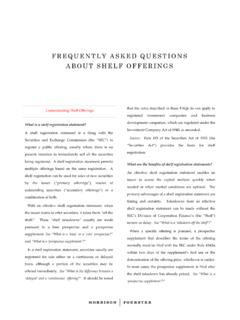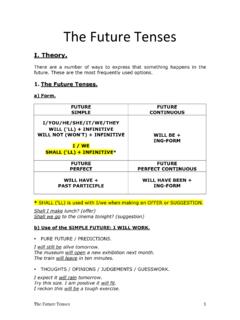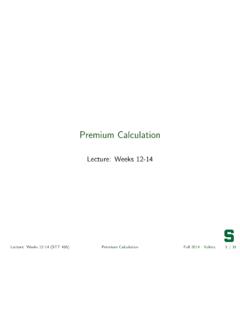Transcription of Non-Dwelling 13 - University of Central Florida
1 ObjectivesAfter studying this unit, the student will:IntroductionUnit 13 contains a Non-Dwelling load calculation form, along with a detailed explanation of each calculations are covered in Unit 8 (one-family) and Unit 11 (multi-family) of this text. Unlikedwelling unit load calculations, receptacle outlets are counted. Receptacle outlets (if known) and fixedmultioutlet assemblies (if any) are entered into the calculation, and if the load is great enough, a demandfactor is applied. As with dwelling-unit load calculations, general lighting is computed using outsidedimensions. Other items, such as a sign outlet (where required) and show window(s) (if present ) are partof the Non-Dwelling load calculation. continuous Loads (Line 10) is a very important computation.
2 Allcontinuous load ratings must be increased by 25%. While Kitchen Equipment (Line 11) is not included inevery type of calculation, be aware that kitchen equipment is not limited to restaurants. For instance,kitchen equipment could be a portion of a load calculation for a school. Line 14 (All Other Loads) is acatchall for any load not included otherwise in the load calculation form has little room for listing individual items, such as motors, equipment, upon the size of the occupancy, the calculation could contain hundreds, if not thousands, ofindividual items. Space is also limited for certain calculations. When the need arises, simply attach addi-tional sheets of paper containing extra items and/or calculations. Some procedure(s) will not apply tocertain load calculations.
3 It is recommended that a line not be left completely empty. Some predeterminedmarking should fill the space; , a dashed line, the letters NA, etc. One of the procedures (Line 4) isapplicable only in banks and office buildings where the actual number of receptacle outlets is a good understanding of the elementsrequired to perform a Non-Dwelling that receptacle outlets are counted,unlike dwelling-unit load how to apply Table 220-13demand factor to receptacle loads in excessof 10 able to compute the receptacle load forbanks and office buildings where the actualnumber of receptacle outlets is familiar with volt-ampere unit loads fordifferent types of occupancies, and even fordifferent areas within certain when and how to apply Table 220-11demand aware that track lighting is computed inaddition to the general lighting when to include a sign and/or outlinelighting outlet in a load the method for calculating showwindow lighting able to determine whether a load is con-tinuous or that continuous loads requirethe inclusion of an additional 25% volt-ampere rating in the load that the load calculation rating repre-sents only a minimum Load CalculationsThe load calculation form results (overcurrent protection and conductors) represent only a minimumrequirement.
4 No consideration is given for the addition of future electrical loads. The size service and/orfeeder is not restricted to the form s calculated size. For example, an electrician might install a 200-ampereservice in an occupancy where the load calculation only required a 125-ampere certain cities, states, etc. require that some (if not all) electrical installations be designed by alicensed Electrical Engineer, caution is advised. Check with local authorities to determine these, as well asother, LOAD CALCULATIONSnLine 1 Receptacle Load266 SECTION 4: COMMERCIAL LOCATIONS1 Receptacle Load (noncontinuous) 220-3(b)(9)Multiply each single or multiple receptacle on one strap by 180 each single piece of equipment comprised of 4 or more receptacles by 90 VA per receptacles located inhotel/motel guest rooms areincluded in the general lightingload calculation, no additionalload calculation is load of 15,300 volt-amperes would be placedin Line 1 for a commercialoccupancy having 75duplex and 10 singlereceptacles.
5 (75 + 10 =85 180 = 15,300)General purposereceptacles are notcontinuous outlets are computed at a minimum of180 volt-amperes for each single (or multiple) recep-tacle on one strap 220-3(b)(9) (See Unit 12).A single piece of equipment (consisting offour or more receptacles) must be com-puted at no less than 90 volt-amperes perreceptacle 220-3(b)(9) (See Unit 12).2 Fixed Multioutlet Assemblies (noncontinuous) 220-3(b)(8)Where not likely to be used simultaneously, multiply each 5 foot section by 180 likely to be used simultaneously, multiply each 1 foot section by 180 fixed multioutletassemblies in hotel/motelguest rooms are includedin the general lightingload calculation, noadditional load calcula-tion is commercial occupancy has 75 linear feet of fixed multioutlet assem-bly, with 15 feet of the assembly subject to simultaneous use.
6 A loadof 4,860 volt-amperes is placed in Line 2, because 75 15 = 60 feet(non-simultaneous); 60 5 = 12 180 = 2,160 volt-amperes for non-simultaneous use multioutlet assembly; 15 180 = 2,700 volt-amperes for simultaneous use multioutlet assembly, and; 2,160 +2,700 = 4,860 volt-amperes total for multioutlet simultaneous use of appliances is unlikely, each5 feet or fraction thereof (of separate and continuouslengths) are considered one outlet of no less than 180volt-amperes 220-3(b)(8)(a) . The number of re-ceptacles within the 5-foot measurement is simultaneous use of appliances islikely, each 1 foot or fraction thereof shallbe considered one outlet of no less than180 volt-amperes 220-3(b)(8)(b) .nLine 2 Fixed Multioutlet Assembly LoadUnit 13: Non-Dwelling Load Calculations267 Non-Dwelling Feeder/Service Load Calculation1 Receptacle Load (noncontinuous) 220-3(b)(9)Multiply each single or multiple receptacle on one strap by 180 each single piece of equipment comprised of 4 or more receptacles by 90 VA per Multioutlet Assemblies (noncontinuous) 220-3(b)(8)Where not likely to be used simultaneously, multiply each 5 foot section by 180 likely to be used simultaneously, multiply each 1 foot section by 180 Load Demand Factor (for nondwelling receptacles) 220-13If the receptacle load is more than 10,000 volt-amperes, apply the demand factor from Table lines 1 and 2.
7 Multiply the first 10 kVA or less by 100%. Then, multiply the remainder by 50%.4 Unknown Receptacle Load (Banks and Office buildings only)Where the actual number of general purpose receptacle outlets are1 xxxxxxxxxxxxxxxxxxxx=4unknown, include 1 volt-ampere per sq. ft. Table 220-3(a) footnote b(sq. ft. outside dimensions)5 General Lighting Load Table 220-3(a)Multiply the volt-ampere unit load (for the type ofxxxxxxxxxxx xxxxxxxxxxxxxxxxxxxx=5occupancy) by the square foot outside dimensions.(VA unit load) (sq. ft. outside dimensions)6 Lighting Load Demand Factors Table 220-11 demand factors to certain portions ofhospitals, hotels, motels, apartment houses (without provisions for cooking), and storage not include areas in hospitals, hotels, and motels where the entire lighting will be used at one Lighting (in addition to general lighting) 220-12(b)Include 150 volt-amperes for every 2 feet,xxxxxxxxxxxx 2xxxxxxxxxxxx 150=7or fraction thereof, for lighting track.
8 (total linear feet)8 Sign and/or Outline Lighting Outlet (where required) 220-3(b)(6)Each commercial building (or occupancy) accessible to pedestrians must have at least one8outlet per tenant space entrance. 600-5(a) Each outlet must be at least 1,200 Window Lighting 220-12(a)Include at least 200 volt-amperes for each linear foot,xxxxxxxxxxxxxxxxxxxxxxxxx 200=9measured horizontally along the show window s base.(total linear feet of show window)10 continuous Loads 215-2(a), 215-3, and 230-42(a)..Multiplythe continuous load volt-amperes (listed above) by 25%.xxxxxxxxxxxxxxxxxxxxxxxxxx 25%=10(General purpose receptacles are not considered continuous .)(total continuous load volt-amperes)11 Kitchen Equipment 220-20 Multiply three or more pieces of equipment by Table 220-20 demand factor (percent).
9 11 Use Table 220-19 for household cooking equipment used in instructional programs. Table 220-19 Note 512 Noncoincident Loads smaller of two (or more) noncoincident loads can be omitted, aslong as they will never be energized simultaneously (such as certain portions of heating and A/C systems).12 Calculate fixed electric space heating loads at 100% of the total connected load. 220-1513 Motor Loads 220-4(a), 430-24, 430-25, 430-26, and Article 440 Motor-driven air-conditioning and refrigeration equipment is found in Article the largest motor (one motor only) by 25% and add to Other Loads ..Add all other noncontinuous loads into the calculation at 100%.14 Multiply all other continuous loads (operating for 3 hours or more) by 125%.15 Total Volt-Ampere Demand Load:Add Lines 3 through 14 to find the minimum required AmperesDivide the total 161717volt-amperes byxxxxxxxxxxxxxxxxx xxxxxxxxxxx=the voltage(line 15) (voltage) (minimum amperes)18 Size the Service and/or Feeder Conductors.
10 Tables 310-16 through 310-19 Use the tables along with Section 310-15(b)(1) through (7) to determine conductor the overcurrent device is rated more than 800 amperes, the conductor ampacity18must be equal to, or greater than, the rating of the overcurrent device. 240-3(c)19 Size the Neutral Conductor 220-22 The neutral service and/or feeder conductor can be smaller than the ungrounded(hot) conductors, but not smaller than the maximum unbalanced load determinedby Article 220. Section 250-24(b)(1) states that the neutral cannot be smaller than19the required grounding electrode conductor specified in Table 250-66. A furtherdemand factor is permitted for any neutral load over 200 the Grounding Electrode Conductor (for Service) 250-66 Using line 18 to find the grounding electrode conductor in Table the Equipment Grounding Conductor (for Feeder) 250-12220 Use line 17 to find the equipment grounding conductor in Table grounding conductor types are listed in Section SizeService and/orFeeder 240-6(a)Minimum SizeConductorsMinimum SizeNeutral ConductorMinimum Size Grounding Electrode GroundingConductor3 Receptacle Load Demand Factor (for nondwelling receptacles) 220-13If the receptacle load is more than 10,000 volt-amperes, apply the demand factor from Table lines 1 and 2.








